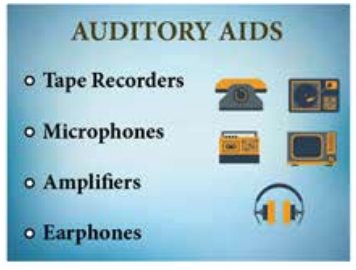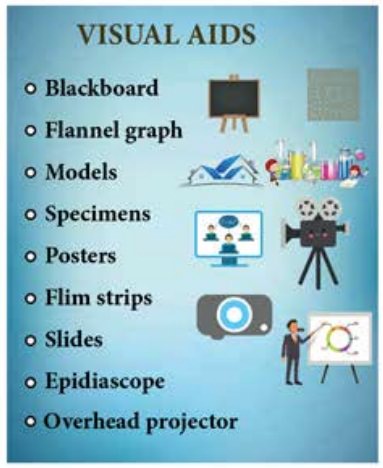Types, Selection and uses | Nursing - Audiovisual Aids | 11th Nursing : Chapter 10 : Health Education and Audio visual Aids
Chapter: 11th Nursing : Chapter 10 : Health Education and Audio visual Aids
Audiovisual Aids
Audiovisual Aids
Audiovisual aids play
an important role in health education. They can be classified into three groups
– purely auditory aids, purely visual and a combination of both auditory and
visual aids
Media or materials in
health education can be used for different purposes and for different groups of
people. Learning and understanding seems to result when more senses, such as
touch, sight and hearing are reached by the media.
If used properly they
create interest and motivate people to learn. Learning is made more permanent
because these aids supply a concrete basis for learning rather than abstract
thinking.
Types of Audio – Visual Aids:
No health education
can be effective without audio – visual aids. Audio-visual aids can be
classified into 3 groups – (1) purely auditory; (2) Purely visual; (3) combined
audio-visual.
(1) Auditory Aids

(2) Visual Aids

Combined Audio-Visual Aids
·
Sound films
·
Slide tape combination
·
Television
·
Computer & Internet
·
A Knowledge of the advantages, disadvantages and limitations of
each audio-visual and is necessary in order to take proper use of them.
Audio-visual aids are means to an end; not an end in themselves.
Audio Visual Aids (Used in Mass Media:)
1.
Posters: Posters are intended
to attract public attention. Therefore, the material needs artistic
preparation. The message on the poster should be short, simple, direct and one
that can be taken at a glance and easy to understand. The life of a poster is
usually short and needs frequent replacement. As a medium of health. Education,
posters are not effective in changing human behavior.
Posters should be colourful to catch the eye
and convey the message clearly, Simple language and short sentences should be
used. If used in the clinic, Outpatients department or health centers, they
should be changed frequently. When possible explain the message to the learners
and use them to supplement the teaching
2.
Health Magazines: A good health magazine
can be an important channel of communication. The material needs expert
presentation.
The Swasth Hind from Delhi and World Health
from WHO are important health magazines. The health magazines stimulate
awareness among people.
3.
Press: Newspapers are the
most widely distributed of all forms
of reading material. They are an important channel of communication to the
people.
4.
Films: Films are very
expensive to produce, and they get
out-of-date very quickly. But film-shows attract large gathering.
5.
Radio and TV: These are found nearly in every home. They are potent
instruments of education. Radio talks should not exceed 15 minutes.
6.
Health Exhibitions: If properly organized, health exhibitions can
attract large numbers of people. Health exhibitions are used in connection with
key points of interest – e.g., fairs and festivals, mass campaigns, etc.
7.
Health Museums: A good health museum can be a very effective mass
media of education, such as the one at Hyderabad in Andhra Pradesh.
8.
Indigenous Media: Indigenous Media like katha-vartha, prabhat
pheries, songs and dramas have roots in our culture. Health messages can be
carried through these media.
Selection and uses of Audiovisual Aids
The following criteria
are guides for the selection of the books and other printed teaching materials.
How each applies in a given instance depends upon the teaching objectives,
which have been set up to meet particular needs.
Criteria for selecting Audiovisual Aids
1.
The facts should be scientifically accurate
2.
Needed materials should be present
3.
All the information should be pertinent
4.
It should cover the entire requirements
5.
All the ideas should be essential, significant and important to
clear understanding.
Related Topics